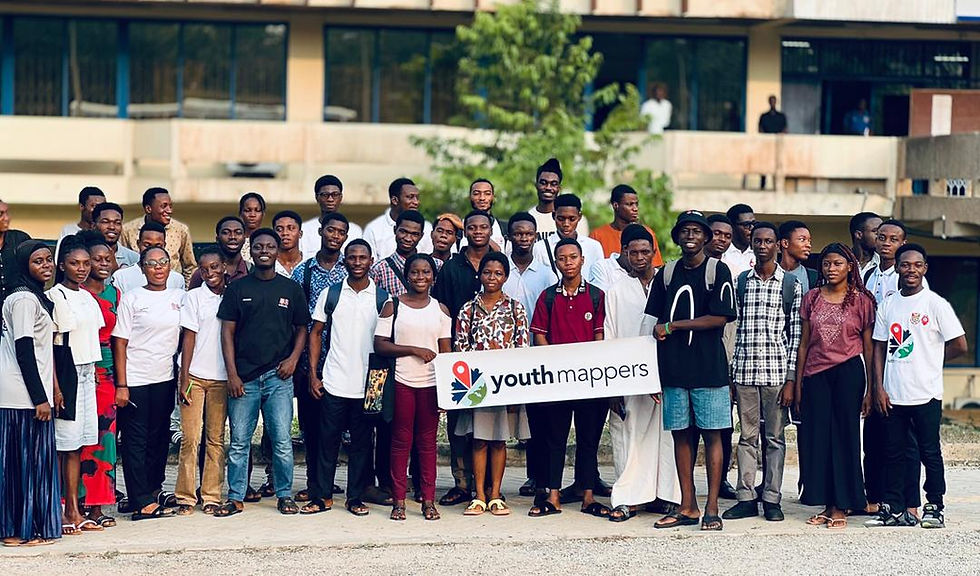Empowering Communities Through Collaboration: YouthMappers, USAID, and HOT's Geospatial Impact
- Maurine Oyugi & Mary Muthee
- Nov 20, 2024
- 4 min read
Updated: Jan 8
Collaborations are crucial in accelerating the contribution and use of open geospatial data. Organizations like YouthMappers, the Humanitarian OpenStreetMap Team (HOT), and the United States Agency for International Development (USAID) are at the forefront of these efforts. YouthMappers is an international network of university-student-led chapters that leverage public geospatial technologies to organize, collaborate, and implement mapping projects for humanitarian purposes. The network also includes researchers, scholars, and educators who use these tools to address development and environmental challenges globally. Similarly, HOT is a global nonprofit dedicated to supporting disaster response, humanitarian aid, and sustainable development by enabling communities to create and utilize open geospatial data. USAID partners with YouthMappers and HOT to enhance the accessibility and impact of open geospatial data in addressing global challenges. Through its funding and technical assistance, USAID empowers communities and organizations to leverage geospatial data for disaster preparedness, response, and sustainable development projects, amplifying the reach and effectiveness of open data solutions worldwide.

On October 31, 2024, USAID, HOT, and YouthMappers student leaders convened at the HOT Eastern & Southern Africa Hub office in Nairobi for a dynamic and impactful forum. Adele Birkenes from the USAID GeoCenter, Tabby Nyanjui, and Pauline Omagwa of HOT hosted the event, with coordination support from Maurine Oyugi, who facilitated the participation of student leaders. It provided an opportunity to showcase diverse projects, including mapping student housing, flooding, and health facilities without electricity, capturing crop data to improve machine learning models, and conducting remote earthquake mapping in Syria and Turkey. These presentations highlighted the innovative ways YouthMappers are using geospatial data to tackle real-world challenges, sparking an enriching exchange of ideas with HOT and USAID Kenya representatives. USAID and HOT outlined their initiatives, inviting chapters to collaborate on future projects and emphasizing the potential for transformative partnerships. HOT offered support by providing technical assistance and hosting mapathon spaces, equipping YouthMappers with the needed resources to thrive. USAID encouraged participants to seize leadership and professional development opportunities such as the YALI Network, empowering them to broaden their impact beyond mapping. The forum not only strengthened existing connections but also inspired new collaborations, leaving participants motivated and better equipped to drive meaningful change through open geospatial data.

The chapters represented in the meeting included the University of Nairobi, Technical University of Kenya, Jomo Kenyatta University of Agriculture and Technology, Kenyatta University, and Dedan Kimathi University of Technology. USAID Kenya was represented by Eric Kabuchanga, Margaret Mwangi, and Paul Odumbe, who provided insights and motivation, sharing strategies for accessing professional opportunities in Kenya's dynamic landscape. Adele and Dr. Brent McCusker represented the USAID GeoCenter.

Adele delivered an engaging presentation on YouthMappers' transformative work. She highlighted their mission to build a global network of university students using mapping to address local and global development challenges. Moreover, she accentuated various projects such as improving crop forecasts in Tanzania by collecting data to train machine-learning models, mapping healthcare facilities without electricity in Nigeria, and strengthening disaster response through remote mapping of earthquake-affected areas in Turkey and Syria. Through compelling examples, Adele showcased how YouthMappers' projects are making a tangible difference in communities worldwide.
HOT’s team shared their experiences in mapping for disaster preparedness, focusing on their efforts in Malawi to combat the devastating impacts of flooding. They illustrated how accurate geospatial data has been pivotal in saving lives, improving community resilience, and informing disaster management strategies. Personal stories from Malawian villages emphasized the real-life impact of their work, painting a vivid picture of transformation and hope.

Student leaders also presented their accomplishments over the past year. They highlighted diverse activities, from mapping underserved communities to hosting workshops and training sessions that empower local populations with geospatial skills. Some of the notable presentations included the Jaramogi Oginga Odinga University of Science and Technology (JOOUST) Mapathon, held on October 28-29, 2023, aimed to map off-campus student accommodations in Bondo Town and make them accessible on OpenStreetMap (OSM). Coordinated by Maurine Oyugi, the Kenya Regional Ambassador, and supported by Dr. Peter M. Samburu and chapter chairperson Felix Murimi, the event introduced participants to geospatial tools like QGIS and QField. Led by Levis Ruto, students collected GPS coordinates and mapped hostels, capturing key attributes such as the hostel name, type (e.g., male or female), photographs, and contact information of those comfortable sharing. This data was processed using QGIS and uploaded to OSM via JOSM. Over two days, the team successfully mapped 100 hostels, improving students’ accessibility. The event concluded with a team-building session, celebrating the achievement of its objectives. This data has also been used by other sectors such as the internet providers who have used it to supply their service to the hostels. Find the project write-up here.

Another notable project was the 20-year celebration of OpenStreetMap (OSM) through a desktop and field mapping exercise at the University of Nairobi (UoN), organized in partnership with TomTom. The initiative allowed participants to engage with advanced mappers and contribute data in preparation for the State of the Map conference. Mapping schools to facilitate HPV vaccination distribution projects led by the Clinton Health Access Initiative (CHAI) targeted girls aged 10-17 by providing crucial health data for reaching vulnerable populations. YouthMappers chapters played a vital role in data collection and engagement. All students’ presentations can be found using this YouTube Link.
The meet-and-greet was a testament to the power of collaboration, showcasing how partnerships between organizations like USAID, HOT, and YouthMappers can amplify the impact of geospatial technology in tackling critical global challenges. The participants left inspired, equipped with new ideas, and ready to scale up their efforts in using maps to make a difference.
About the Authors

Maurine Oyugi is a Former YouthMappers Regional Ambassador, 2023 YouthMappers Leaders Fellow, and a GIS Consultant at Planate Managements Group.

Mary Muthee is a Geospatial Data Analyst and a 2024 YouthMappers Leaders Fellow.




Comments